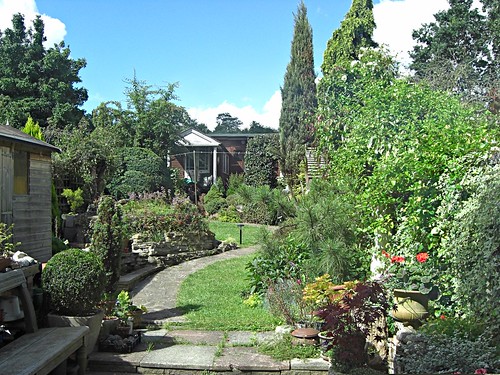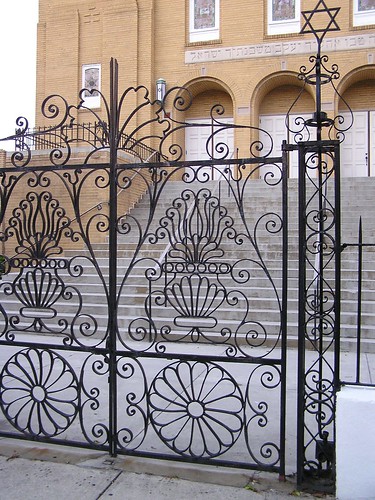Back garden, summer 2007
Image by Darkroom Daze
Our back garden in summer morning sun. Westward view from the house terrace in July.
In wintry contrast to this view, see almost the same one during falling snow in late autumn, three years later.
NOTE ON THE GARDEN
The garden was very plain and bare when we arrived in 1985. We have been developing the design gradually since then, but not from a single pre-planned conception. Eventually we developed the overall shape, with a 'winding river' effect made by the lawns and path. The shapes of the rockeries, planting and other features are based on the way a small stream winds between 'interlocking spurs' in hilly terrain. We did all the planting, and I built many of the features. For further history of our garden, see set description for 'OUR BACK GARDEN'
GARDEN DETAILS
To see the garden details better, go to Actions (top L) > View all sizes > Original. See also notes on picture. However, notes are not retained in downloaded versions of Flickr images.
Features
- Arbour - centre R, only slat-roof visible, assembled from flat-pack.
- Bike shed - far L, assembled by supplier.
- Border - nearest planting on R by strip of lawn, mostly flowering shrubs.
- House Terrace (patio) - foreground, made of rough green and pink concrete slabs set in 'chequer-board' pattern, with container plants. This was here before we came and we plan to re-landscape it.
- Lower Rockery and mixed shrub border - R of nearer part of path, but the rockery proper is not visible here.
- Path - of reclaimed York stone laid in 'crazy' style by local landscaper, late Mr. Rogers, to our own winding design, shortly after we arrived in 1985.
- Temple of Juno garden shed - centre L, with shingled roof and white columns supporting portico, built by me in sections out of reclaimed timber ("Rosen Wanted") at a previous house, brought here and extended with portico. I made the columns made from a flag pole. Steve Cruse (joiner) hung the doors (architectural salvage) and put on the cladding.
- Upper Rockery (Railway Rockery) - centre, planted with alpines, dwarf shrubs and trees including conifers, also the base for the Upper Loop of Garden Railway. Rockery built myself of various kinds of stone in simulated geological structure (not visible here).
- Valrosa Cabin workshop - centre background, brown, fully insulated, completed earlier in the year by Acer Landscapes.
- Water Rockery - centre L, with pumped water course, upper pools, cascades, and lower loop of garden railway (but these details not visible here). Almost all built myself.
Plants
(including some in neighbours' gardens)
- Acer palmatum 'Fire Glow' - Japanese maple, in container on terrace front R.
- Acer shirasawanum 'Aureum' - Japanese maple, in container on terrace front R.
- Buxus sempervirens - in concrete container, grown from seedling, shaped into globe., L foreground, and jelly-mould box-hedge, centre L.
- Chamaecyparis - probably C. lawsoniana, Lawson's cypress, 'Stewartii' or 'Westermannii' - neighbours' tall bright conifer on R skyline.
- Chamaecyparis lawsoniana 'Ellwood's Pillar' - Lawson's cypress, in container, on terrace near bike shed, near L.
- Clematis armandii - further part of hedge on R.
- Clematis cirrhosa var. balearica - on L near bike shed, growing over old apple tree stumps.
- Cotoneaster frigidus - centre L skyline.
- Eccremocarpus scaber f. carmineus - red Chilean glory flower, climbing around front of Water Rockery, centre L.
- Escallonia macrantha - two shrubs shaped into an arch over side path, L side only visible here, centre R.
- Hebe armstrongii or similar whipcord form - bright green, on L near bike shed.
- Hedera helix - ivy, variegated form, forming nearest hedge, on R.
- Juniperus scopulorum 'Skyrocket' - pillar juniper, centre R.
- Lonicera japonica - Japanese honeysuckle, evergreen, part of R hedge.
- Origanum vulgare - origano / wild marjoram, in flower on Water Rockery, centre L. Very vigorous and has overgrown the rockery too much.
- Origanum vulgare 'Aureum' - golden marjoram, at front of Upper Rockery, centre, and on R of nearer lawn.
- Pelargonium - aka 'Geranium', in container on terrace, front R.
- Picea glauca var. albertiana 'Conica' - dwarf white spruce, two trees one behind the other, L of centre on Upper Rockery.
- Picea mariana 'Nana' - dwarf black spruce, L of centre on Upper Rockery.
- Pinus nigra - Austrian/black pine, in container near R, so rather like a large bonsai.
- Platycladus orientalis 'Beverleyensis' - (formerly Thuja orientalis) golden form of Eastern Thuja, tip just visible L, over roof of bike shed.
- Pyracantha probably P. x watereri - in neighbours' garden, towards top R, with white blossom.
- Pyrus probably P. communis - common pear tree, in neighbours' garden, top L.
- Quercus - probably Q. robur L., pedunculate oak, growing along fence behind a neighbouring garden, top R.
- Syringa meyeri 'Palibin' - miniature lilac, centre on Upper Rockery.
- Viburnum davidii - to R of nearer lawn.
LOCATION DETAILS
Country: Great Britain: England
City: London
London Borough: Lambeth
District: West Dulwich, SE21
Altitude: 40m
Aspect: This border and hedging on the R face approx. S. View is westward.
Photo
© Darkroom Daze Creative Commons.
If you would like to use or refer to this image, please link or attribute.
ID: CIMG003
Charleston, Rutledge Avenue
Image by hdes.copeland
Evolution of the stylized shell design begins in Georgian architectural details of Charleston.
It was no small irony that Charleston's orthodox Jewish congregation wanted a design that strongly reflected their Charleston roots for the gate to the new synogogue completed in the late 1940's. Not merely a symbol of Georgian Charleston style, it alluded to the roots of the city which tied many groups and the city's historic fortunes to European trade. From that point the circle is extended further and only underscores how styles and meanings evolve. A Jewish congregation in Charleston with perfect logic and reasonable association can use a symbol long connected to a Christian shrine located in Moorish Spain where Sephardic Jews once florished.
Miles Brewton, a merchant who traveled often to England and the ports of mainland Europe, brought back this fence from one of his trips while his grand townhouse was still under construction in the 1760's. Though the iron work may have been salvaged or just surplus, it became an iconic example and template for what Charlestonians demanded of their builders for generations afterwards.
This particular shell design is now believed to have come from Bordeaux, where Brewton sold great quanities of Carolina Gold rice as did many others from Charleston. The shell design in iron and stone became the symbol of the religious pilgrims' route through central, northern and western Europe to the Shrine of St. James which was in northern Spain. The shell was the mark of St. James. Eventually it became a sign to religious travelers that they were on the correct road, many of which led to Bordeaux before reaching their destination in Spain.
Charleston, SC. Photo taken August 2010.
Photo and text posted: 15 August 2010
Revised: 26 September 2010
Copyrights reserved: hdescopeland
POND13_014_009.bmp
Image by Gary Hayes
A view as the moon sets - the fencing is deliberately reversed vertical on each side for visual look
POND21_014_020.bmp
Image by Gary Hayes
and with glass inserts roughly in position and Ward adding fencing all around the edge
65th St., Middle Village
Image by jann_on
No comments:
Post a Comment